Selected Key Prosecution Evidence in the Amanda Knox- Raffaele Sollecito Murder Trial
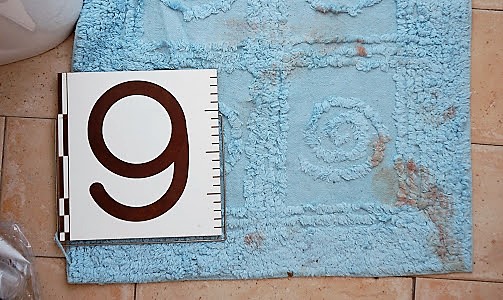
The bloody footprint on a bathmat found in the villa. Whose footprint is it?
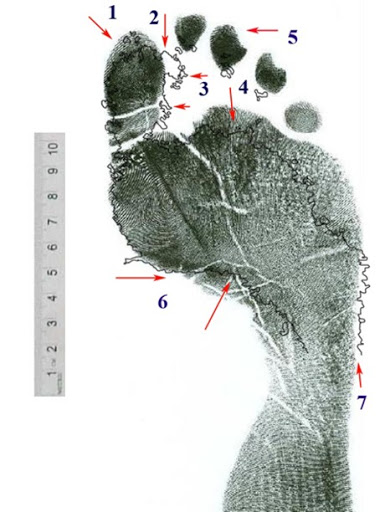
A bare foot print, set in blood, was on the bottom left corner of the bathmat of a bathroom in the villa. The prosecution argued that the footprint was made by Raffaele Sollecito, and that it was too small to have been left by Rudy Guede. But, in fact, the forefoot region of Guede's foot is neither longer nor wider that Raffaele's.
The print was incorrectly measured. Closer inspection shows that the tip of the second toe blended with the top of the big toe. The absorbent nature of the mat may have lea to natural spreading of blood and the print is bloody water, not pure blood. This error in measurement is crucial because the prosecution based the compatibility of Raffaele’s foot on the width of his big toe. Raffaele’s big toe measured 30mm and is therefore incompatible with the measured foot on the bathmat, which when measured correctly, shows a toe print of 24.8mm. At trial, Sollecito's forensics expert Francesco Vinci testified convincingly that the bathmat print did not match Raffaele's foot.
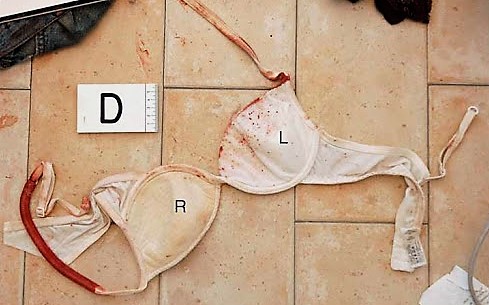
Meredith Kercher's bra clasp
Prosecution Exhibit #165 was a bra clasp was photographed on the floor of Meredith Kercher’s room on November 2nd, 2007 but not collected as evidence on December 18th. It was recovered four or five feet away from where it was originally photographed. Unsurprisingly, DNA analysis of the clasp showed that Meredith Kercher was the primary DNA donor on the bra clasp. Prosecutors also claimed to have found DNA consistent with Raffaele Sollecito’s DNA on the clasp. But The Y-haplotype testing for the bra clasp showed peaks belonging to at least three unknown male profiles, besides the one attributed to Raffaele Sollecito, strongly suggesting contamination. The bra clasp moreover couldn’t be tested by the independent experts because it was either intentionally destroyed at worst or stored incorrectly, allowing the hooks to rust from storage in extraction buffer. The evidence was rendered useless.
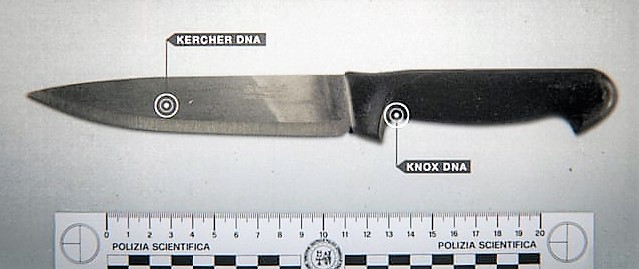
The kitchen knife found at Sollecito's apartment.
Prosecution Exhibit #36 was a knife discovered in the kitchen drawer of Raffaele Sollecito’s apartment on November 6, 2007. The police claimed this knife, 31 m long with a 17.5 cm blade, to be the murder weapon. It was the only physical evidence linking Amanda Knox to the murder. The Scientific Police claimed to have found Knox’s DNA on the handle and Kercher’s DNA on the blade and called the knife the “double DNA knife.”
In his decision explaining the guilty verdict in the 2009 trial, Judge Massei wrote that it was “possible and in fact probable” Amanda Knox carried the knife around in her cloth bag. He suggested Amanda Knox used the knife to slash Meredith Kercher’s throat because Meredith rejected the sexual advances of Rudy Guede.
Later re-evaluation of the knife left little doubt that the DNA found on the knife was the result of contamination. The Italian Supreme Court (Court of Cassation) would say of the knife: “In conclusion, it can be established that the appealed sentence fell into a serious misrepresentation of a decisive piece of evidence, that, if properly evaluated, would have permitted to ascertain the occurrence of laboratory contamination.”

The broken window in Filomena's room.
A window in the Filomena Romanelli’s room at the villa had been broken, apparently by a rock. The prosecution argued that the rock was actually thrown through the window from inside the villa as part of an attempt to make the murder appear to be the result of a robbery. According to the prosecution, the staging also included the ransacking of Romanelli’s room.
Four witnesses including two officers of the State Police, testified that the glass from the broken window was on top of the displaced items indicating that the room had been ransacked prior to the window being broken, while valuables in plain sight were not touched. They also suggested that the rock selected to break the window was illogical both because of the size and weight.
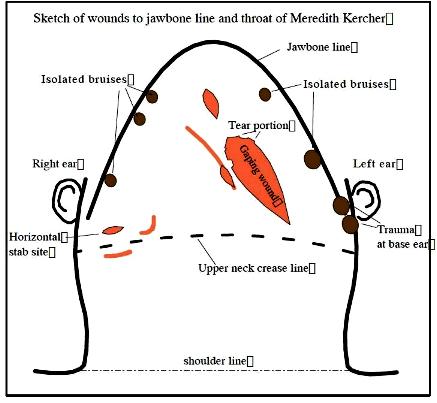
According to forensic experts, the knife inflicting the mortal wound almost certainly was thrust with considerable force into the throat to the full depth of the blade. The killer then pulled the knife upward with maximum force increasing the length of the gaping wound. If Sollecito’s knife had in fact inflicted the mortal wound to Kercher, the depth of the wound would be expected to be much deeper than the wound measured in the autopsy.
